Types of Suspension Springs
Following are the five different types of Suspension springs used in automobile vehicles:
- Leaf springs
- Coil spring
- Torsion spring
- Airbags
- Rubber spring
Read also: What is Suspension System: How it Works? and Types of Suspension System
#1 Leaf Spring
Leaf spring consists of a number of leaves, made of steel plates, of increasing lengths from the centre. All the leaves are clamped by a centre bolt at the centre and side almost at the sides so that the leaves are in position.

The main leaf is the longer one having bent ends, called the spring eyes. The spring eye is connected to the frame by a shackle. The centre portion of the spring is connected to the front axle by U-bolt.
Types of Leaf springs
Following are the different types of leaf springs.
- Semi-elliptical spring
- Quarter-elliptical spring
- Three-quarter elliptical spring
- Transverse spring
- Full elliptical spring
- Platform type spring
Read also: Types of Axles: Rear Axles, Front Axle and Stub Axle
1.1 Semi-elliptical Springs
Semi-elliptical springs are usually used in all the vehicle. Particularly in trucks, semi-elliptical springs are fitted in front and rear axles.
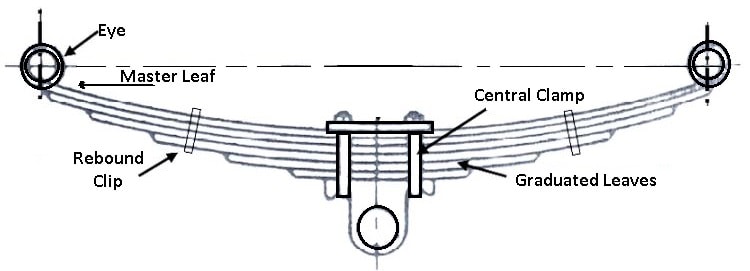
But in cars, they are fitted on the rear axle only and the independent suspension is fitted on the front axle. Semi-elliptical springs are cheaper and require less repairing. They increase the range of spring action and last for a long time.
1.2 Quarter-elliptical Spring

Quarter-elliptical springs were used in old small cars, like Chrysler cars. This type of spring consists only a quarter portion of the full elliptical spring and fitted with the frame by the bolt.
1.3 Three quarter elliptical Spring

Three quarter elliptical spring is the combination of semi-elliptical and quarter elliptical springs. This types of springs was used in old cars.
1.4 Transverse Spring

transverse spring in just like the semi-elliptical spring but inverted in shape. One end of the spring in joined with chassis frame by shackle, and the other end with the axle. It is also fixed with frame by the bolts at the centre.
1.5 Full-elliptical Spring

Full elliptical springs are consists of two semi-elliptical springs joined together oppositely. This type of spring was used in old cars. They do not maintain correct axle alignment.
1.6 Platform Type Spring
Platform type springs consist of two semi-elliptical springs. They are fitted with chassis frame by shackle at one side and the other side is fitted with an inverted semi-elliptical spring. In this arrangement, the weight of the car is divided into three points.
Read also: What is steering system? and how it works? [The complete guide]
2. Helper Spring
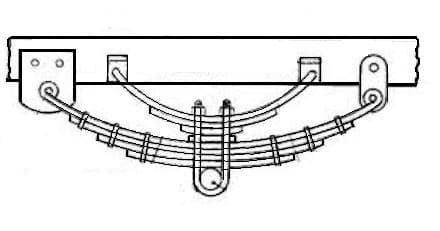
Helper spring is just like a semi-elliptical spring but without eyes at the ends. It is fitted with the main springs particularly on the rear axle of the truck to carry the heavy load. The ends of the helper spring touch the brackets fitted on the frame when the truck is heavily loaded.
3. Coil Springs
Coil springs are made of spring steel. These are described with the independent suspension system.
While providing a wide variety of spring rates, they can be accommodated in all type of confined spaces. As compared to leaf springs they weigh only half the weight required for doing the same job.
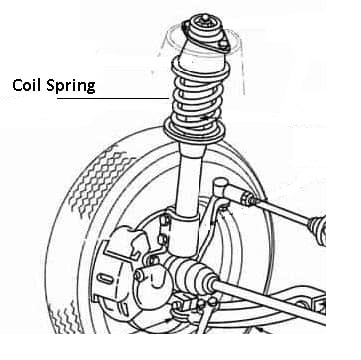
They can also store twice the energy per unit volume in comparison to leaf springs but to control the accelerating, braking and cornering, anti-roll bars or radius roads should be provided. The pan-shaped brackets or spring seats attached to the rear axles are used to seat the coil spring. Spring seats incorporated into the frame are similarly used for compressing springs against them.
The suspension is also used in combination with torque tube or torque rod drive. As regards energy storage i.e. energy stored in a given weight of spring, coil and torsion bar springs are superior to the leaf springs.
4. Torsion Spring
A torsion spring is also used in an independent suspension system. Torsion suspension spring has a rod which acting under the torsion by taking shear stresses.
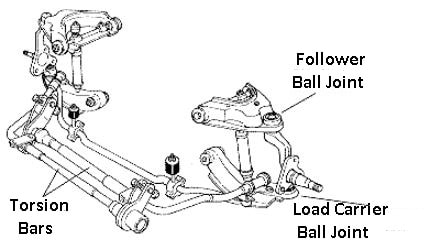
One end of the bar is connected to the frame and another end is connected to the wheel arm and supported in the bearing. The end of the wheel arm is connected to the wheel hub. When the wheel hits a bump, it starts vibrating up and down, thus a torque on the torsion bar start acting as a spring.
5. Air Bags
The airbags and rubber springs are used in foreign cars. Air suspension, hydraulic suspension and hydrogen gas suspension systems are also used in foreign vehicles.
6. Rubber Springs
The rubber springs are used in suspension because it saves greater energy per unit weight than the steel.
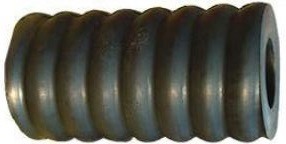
So rubber springs are more compact than other springs. The main advantage of using a rubber spring is that it does not suddenly fail like steel so there is less risk. And also has excellent vibration damping properties.
Download the PDF file of this article
That’s it, Thanks for reading. If you have question or doubt about types of suspension springs ask in the comments. If you like this article please share with your friends.
Subscribe to your newsletter to get notification of our new posts. Its’ Free.
Read more in our blog:
Please send pdf
The PDF file has been sent to your inbox.
send me the pdf file please
The PDF file has been sent to your inbox.
Good stuff ….Please can I have the pdf
Thanks for your feedback. The PDF file has been sent to your inbox.
Please sir send me pdf file
Thanks
The PDF file has been sent to your inbox.
Please sir provide me pdf
I just send you a PDF file of this article to your inbox. Thanks for reading